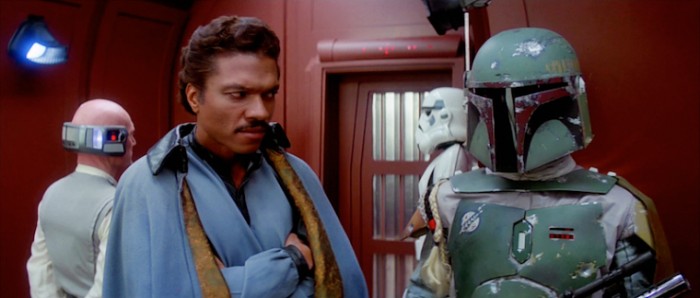Pimpin’ in Space: The Blaxploitation Roots of Lando Calrissian
Solo: A Star Wars Story hits theaters this May, and the character everyone is the most excited to see isn’t Han Solo. It’s Lando Calrissian.
Lando, initially played by Billy Dee Williams and now Donald Glover, has been a huge force (no pun intended) in the Star Wars universe. His personality, good looks, and roguish charm have secured him the honor of being one of the most influential and coolest Star Wars characters of all time. But what many don’t realize is how much Lando’s character stems from another popular genre created before Star Wars hit theaters – blaxploitation.
Lando’s characterization and his style owe a huge debt to blaxploitation. But Lando also adds another layer to the conversation blaxploitation engages in about black images in the media. How does Lando, colloquially called a “space pimp” by fans, contribute to the conversation and in what ways does he actually hinder how blackness is viewed in film? To mediate further on these questions, let’s start with the beginning of blaxploitation itself.
Blaxploitation: the birth of the space pimp
George Lucas’ films from the early 1970s, THX 1138 and American Graffiti, put him on the map as a filmmaking powerhouse. Interestingly enough, the early 1970s is when blaxploitation also became powerful in its own right, laying the foundations for Lucas’ Cloud City swindler.
During the early ‘70s, film sales were waning dramatically. With more white audience members resorting to television and moving away from the cities (where the big theaters were) and into the suburbs, studios began catering towards black audiences, who were moving into the cities and had limited alternatives for entertainment. The genre that would become blaxploitation kicked off with Melvin Van Peebles’ 1971 hit Sweet Sweetback’s Badasssss Song. Being the first of its kind, the film was initially a long-shot for success.
“With no such thing as a marketing budget, Van Peebles released the film’s Earth, Wind & Fire soundtrack before the film, and he would rely on the oral tradition, using strong word-of-mouth support, to help promote Sweetback to eager urban audiences,” wrote The Root’s Todd Boyd. “When the dust cleared, the film’s success made Hollywood pay attention to the existence of an untapped audience. This set in motion a process that would give birth to a genre eventually referred to as ‘blaxploitation’ going forward.”
The introduction of black men and women as leaders of their own stories cemented blaxploitation’s popularity, despite the genre’s harmful themes, such as physical and sexual abuse, hypersexuality, linking blackness and inner-city life to crime and drug use, and hypermasculinity. The genre, which created legendary films like Shaft, Coffy, Cleopatra Jones, and Superfly provided black actors and black audiences a way to create and consume stories starring black characters that would gain mainstream appeal. Several big names in entertainment participated in the genre’s development, like Sidney Poitier, who starred in two sequels to In the Heat of the Night that would serve as a precursor to blaxploitation, They Call Me Mr. Tibbs! and The Organization.
By 1972, Bill Dee Williams was already a Hollywood star and the chief arbiter of cool; his roles in Brian’s Song and Lady Sings the Blues cemented him as a huge talent and as a suave, debonair sex icon. But he also starred in blaxploitation films such like The Final Comedown, Hit! and The Take. Even in these films, Williams also played a compassionate hero looking for justice, further cementing his status as the new king of black Hollywood.
His brand of cool put him on Lucas’ radar, who wrote “Actor – Billy Dee Williams – Cloud City leader” in his Empire Strikes Back story notes.
In the book, The Making of Star Wars: The Empire Strikes Back, J.W. Rinzler wrote that Williams’ sex appeal is what secured him the role of Lando. “His romantic onscreen image is what got Williams the part, according to [Empire Strikes Back director Irvin] Kershner, who says he ‘really looks like a Mississippi riverboat hustler. Billy can do that charm fantastically.”
Ironically, the description of a “Mississippi riverboat hustler” can read as racially-charged, despite Lucas’ irritation at Star Wars being criticized as being racist due to its all-white cast. While Lando is supposed to be a character that acts independently from mainstream black caricature, Lando is still defined by his blackness.
“[Filmmaker, writer, and George Lucas biographer] Dale Pollock reports that Lucas was ‘still smarting from criticism that Star Wars was racist,’ so he ‘conceived of Lando as a suave, dashing black man in his thirties,’” wrote Kevin J. Wetmore Jr., author of The Empire Triumphant: Race, Religion and Rebellion in the Star Wars Films. “The irony is that Billy Dee Williams was interested in the role precisely because the character wasn’t specifically black – there is nothing inherent in the script that makes Lando a person of color, other than the fact that specified in the script is that half the residents of Bespin are black. Of course, in the final version, only two or three residents of Bespin are black.”
Lando further defines the mainstream image of blackness as being one synonymous with coolness and slickness. But with that image comes negative associations of blackness; being shifty, dangerous, and untrustworthy. It’s unclear if Lucas was directly inspired by blaxploitation, but blaxploitation’s pervasiveness certainly informs Lando’s character, from the cape to his roguish personality. There’s a reason why many fans refer to Lando as a pimp in space.
Continue Reading The Blaxploitation Roots of Lando Calrissian >>
The post Pimpin’ in Space: The Blaxploitation Roots of Lando Calrissian appeared first on /Film.
from /Film http://ift.tt/2oDeHv7


Comments
Post a Comment